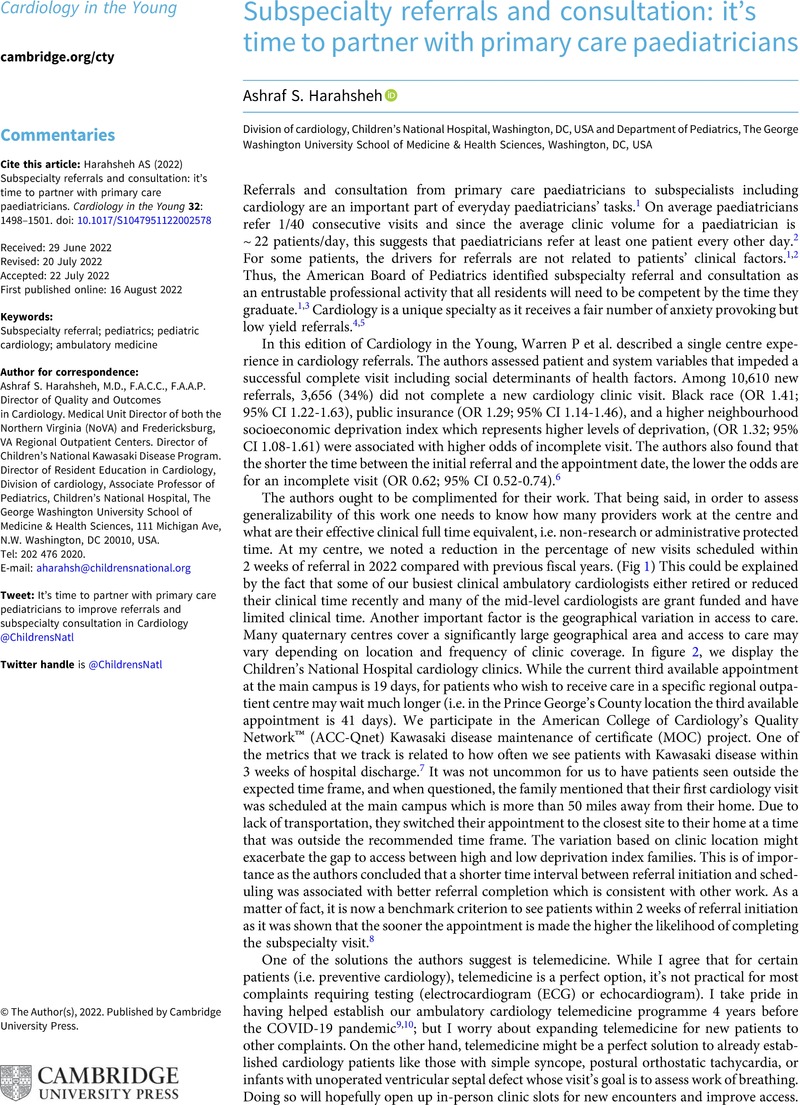No CrossRef data available.
Article contents
Subspecialty referrals and consultation: it’s time to partner with primary care paediatricians
Published online by Cambridge University Press: 16 August 2022
Abstract
An abstract is not available for this content so a preview has been provided. Please use the Get access link above for information on how to access this content.

- Type
- Commentaries
- Information
- Copyright
- © The Author(s), 2022. Published by Cambridge University Press
Footnotes
Tweet: It’s time to partner with primary care pediatricians to improve referrals and subspecialty consultation in Cardiology @ChildrensNatl
Twitter handle is @ChildrensNatl
References
Hamburger, EK, Lane, JL, Agrawal, D, et al. The referral and consultation entrustable professional activity: defining the components in order to develop a curriculum for pediatric residents. Acad Pediatr 2015; 15: 5–8.CrossRefGoogle ScholarPubMed
Forrest, CB, Glade, GB, Baker, AE, Bocian, AB, Kang, M, Starfield, B. The pediatric primary-specialty care interface: how pediatricians refer children and adolescents to specialty care. Arch Pediatr Adolesc Med 1999; 153: 705–714.CrossRefGoogle ScholarPubMed
Englander, R, Hicks, P, Benson, B. Pediatrics milestones: a developmental approach to the competencies. J Pediatr 2010; 157: 521–2, 22 e1.CrossRefGoogle Scholar
Harahsheh, AS, OʼByrne, ML, Pastor, B, Graham, DA, Fulton, DR. Pediatric chest pain-Low-Probability referral: a Multi-Institutional analysis from standardized clinical assessment and management plans (SCAMPs(R)), the pediatric health information systems database, and the national ambulatory medical care survey. Clin Pediatr (Phila) 2017; 56: 1201–1208.CrossRefGoogle Scholar
Tretter, JT, Kavey, RE. Distinguishing cardiac syncope from vasovagal syncope in a referral population. J Pediatr 2013; 163: 1618–23 e1.CrossRefGoogle Scholar
Warren, P, Beck, A, Zang, H, Anderson, J, Statile, C. Inequitable access: factors associated with incomplete referrals to pediatric cardiology. Cardiol Young 2022; 18: 1–26.CrossRefGoogle ScholarPubMed
Teitel, DF, Newburger, JW, Sutton, N, et al. Development and utility of quality metrics for ambulatory pediatric cardiology in kawasaki disease. Clin Pediatr (Phila) 2020; 59: 245–251.CrossRefGoogle ScholarPubMed
Bohnhoff, JC, Taormina, JM, Ferrante, L, Wolfson, D, Ray, KN. Unscheduled referrals and unattended appointments after pediatric subspecialty referral. Pediatrics 2019; 144: 144.CrossRefGoogle ScholarPubMed
Phillips, AA, Sable, CA, Atabaki, SM, Waggaman, C, Bost, JE, Harahsheh, AS. Ambulatory cardiology telemedicine: a large academic pediatric center experience. J Investig Med 2021; 69(7): 1372–1376.CrossRefGoogle ScholarPubMed
Harahsheh, AS, Selekman, RE, Simpson, JN, et al. Children’s hospital ambulatory response to the 2019 novel coronavirus disease (COVID-19) pandemic. J Ambul Care Manage 2021; 44(3): 184–196.CrossRefGoogle Scholar
Dalal, NN, Dzelebdzic, S, Frank, LH, et al. Recurrent cardiology evaluation for innocent heart murmur: echocardiogram utilization. Clin Pediatr (Phila) 2018; 57: 1436–1441.CrossRefGoogle ScholarPubMed
Harahsheh, AS, Hamburger, EK, Saleh, L, et al. Promoting judicious primary care referral of patients with chest pain to cardiology: a quality improvement initiative. Med Decis Making 2021; 41: 559–572.CrossRefGoogle ScholarPubMed
Friedman, KG, Kane, DA, Rathod, RH, et al. Management of pediatric chest pain using a standardized assessment and management plan. Pediatrics 2011; 128: 239–245.CrossRefGoogle ScholarPubMed
Angoff, GH, Kane, DA, Giddins, N, et al. Regional implementation of a pediatric cardiology chest pain guideline using SCAMPs methodology. Pediatrics 2013; 132: e1010–e1017.CrossRefGoogle ScholarPubMed
Harahsheh, AS, Ottolini, M, Lewis, K, Blatt, B, Mitchell, S, Greenberg, L. An innovative pilot curriculum training pediatric residents in referral and communication skills on a cardiology rotation. Acad Pediatr 2016; 16: 700–702.CrossRefGoogle ScholarPubMed
Stave, EA, Greenberg, L, Hamburger, E, et al. An educational intervention to facilitate appropriate subspecialty referrals: a study assessing resident communication skills. BMC Med Educ 2022; 22: 533.CrossRefGoogle ScholarPubMed
Diamond, L, Izquierdo, K, Canfield, D, Matsoukas, K, Gany, F. A systematic review of the impact of Patient-Physician Non-English language concordance on quality of care and outcomes. J Gen Intern Med 2019; 34: 1591–15606.CrossRefGoogle ScholarPubMed
Hsueh, L, Hirsh, AT, Maupome, G, Stewart, JC. Patient-Provider language concordance and health outcomes: a systematic review, evidence map, and research agenda. Med Care Res Rev 2021; 78: 3–23.CrossRefGoogle ScholarPubMed
Parker, MM, Fernandez, A, Moffet, HH, Grant, RW, Torreblanca, A, Karter, AJ. Association of Patient-Physician language concordance and glycemic control for Limited-English proficiency latinos with type 2 diabetes. JAMA Intern Med 2017; 177: 380–387.CrossRefGoogle ScholarPubMed
Traylor, AH, Schmittdiel, JA, Uratsu, CS, Mangione, CM, Subramanian, U. Adherence to cardiovascular disease medications: does patient-provider race/ethnicity and language concordance matter? J Gen Intern Med 2010; 25: 1172–1177.CrossRefGoogle Scholar
Zhao, C, Dowzicky, P, Colbert, L, Roberts, S, Kelz, RR. Race, gender, and language concordance in the care of surgical patients: a systematic review. Surgery 2019; 166: 785–792.CrossRefGoogle ScholarPubMed



